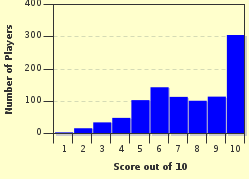Quiz Answer Key and Fun Facts
1. The Guinness Book of World Records lists the world's largest snowflake as being 15 inches wide. This flake and others like it fell in 1887, on Fort Keogh, in which large northern state?
2. Which scientist photographed thousands of snowflakes with one of the world's first photographic microscopes?
3. Snow that falls in the shape of a ball instead of a flake is called which of the following?
4. On rare occasions, snowflakes with three or twelve sides can be found.
5. Most snowflakes are hexagonal, which means they would usually have six sides and meet at six points. What is the proper name for these meeting points?
6. The branches on a snowflake are called radiating ____?
7. What is the name of the chart used for indexing snowflakes and their shapes, which was named after the scientist who invented it?
8. In 1611, which early scientist wrote a short treatise "On the Six-Cornered Snowflake"?
9. Ten inches of snow will melt down to about one inch of water.
10. Snowflakes are just frozen raindrops.
Source: Author
dcpddc478
This quiz was reviewed by FunTrivia editor
crisw before going online.
Any errors found in FunTrivia content are routinely corrected through our feedback system.

